 |
QUICK SEARCH
MO PROJECTS:
Africa
Asia/Pacific
Mesoamerica
North America
South America
General Taxonomy
Photo Essays
Training in Latin
America
MO RESEARCH:
Wm. L. Brown Center
Bryology
GIS
Graduate Studies
Research Experiences
for Undergraduates
Imaging Lab
Library
MBG Press
Publications
Climate Change
Catalog Fossil Plants
MO DATABASES:
W³MOST
Image Index
Rare Books
Angiosperm
Phylogeny
Res Botanica
All Databases
INFORMATION:
What's New?
People at MO
Visitor's Guide
Herbarium
Jobs & Fellowships
Symposium
Research Links
Site Map
Search
THE CLASSIFICATION OF NATURAL AND |
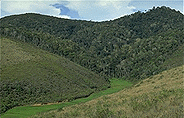 Remnant High Plateau forest providing constant source of water for rice paddies east of Anjozorobe. |
In another study, Trapnell (1959) examined the ecological results of woodland burning experiments at Ndola in Zimbabwe, a station located at 13 degrees S latitude and 1200 m in elevation. Twenty three years of study using several controlled burning regimes clearly showed that Brachystegia - Julbernardia woodland, which also contains many elements common with the drier woodlands on Madagascar, can be totally destroyed by regular late-season burning, precisely the type of burning regime practiced in Madagascar.
VEGETATION DYNAMICS
David Burney and his collaborators have also underlined another important factor that must be taken into consideration. It is clear that the climate and vegetation of Madagascar have changed dramatically over the time scale of tens of thousands of years, and that the extent of various vegetation types has expanded and contracted many times (Burney, 1987a, 1987b).
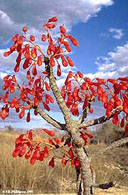 |
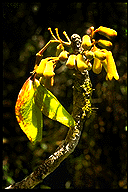 |
This can be inferred from the current distribution of certain plant groups. For example, Hildegardia erythrosiphon is an important tree in the deciduous forests of the west.
The genus is also represented in the heart of the wet forests of
the east by Hildegardia perrieri, which stands out remarkably by
being one of the extremely few deciduous species in otherwise
completely evergreen forest.
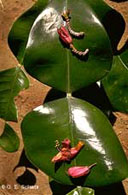 |
Similarly, Phyllarthron, a genus of Bignoniaceae endemic to Madagascar, has about a dozen species, all of which have phyllodes -- the modified petiole/rachis of a compound leaf that has lost its leaflets -- that function like leaf blades. These phyllodes are clearly adaptations to dry environments. Phyllarthron berniereanum occurs in the extremely dry south, where one would expect to see it. But a number of other species (e.g., P. articulatum, P. cauliflorum, and P. antongiliensis), all of which have these distinctive phyllodes, are found in some of the country's wettest forests.
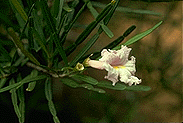 |
© 1995-2025 Missouri Botanical Garden, All Rights Reserved
4344 Shaw Blvd.
St. Louis, MO 63110
(314) 577-5100
Technical Support